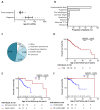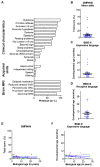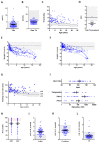Disease characteristics of MCT8 deficiency: an international, retrospective, multicentre cohort study
- PMID: 32559475
- PMCID: PMC7611932
- DOI: 10.1016/S2213-8587(20)30153-4
Disease characteristics of MCT8 deficiency: an international, retrospective, multicentre cohort study
Erratum in
-
Correction to Lancet Diabetes Endocrinol 2020; 8: 594-605.Lancet Diabetes Endocrinol. 2022 Apr;10(4):e7. doi: 10.1016/S2213-8587(22)00082-1. Lancet Diabetes Endocrinol. 2022. PMID: 35325598 No abstract available.
Abstract
Background: Disordered thyroid hormone transport, due to mutations in the SLC16A2 gene encoding monocarboxylate transporter 8 (MCT8), is characterised by intellectual and motor disability resulting from cerebral hypothyroidism and chronic peripheral thyrotoxicosis. We sought to systematically assess the phenotypic characteristics and natural history of patients with MCT8 deficiency.
Methods: We did an international, multicentre, cohort study, analysing retrospective data from Jan 1, 2003, to Dec 31, 2019, from patients with MCT8 deficiency followed up in 47 hospitals in 22 countries globally. The key inclusion criterion was genetically confirmed MCT8 deficiency. There were no exclusion criteria. Our primary objective was to analyse the overall survival of patients with MCT8 deficiency and document causes of death. We also compared survival between patients who did or did not attain full head control by age 1·5 years and between patients who were or were not underweight by age 1-3 years (defined as a bodyweight-for-age Z score <-2 SDs or <5th percentile according to WHO definition). Other objectives were to assess neurocognitive function and outcomes, and clinical parameters including anthropometric characteristics, biochemical markers, and neuroimaging findings.
Findings: Between Oct 14, 2014, and Jan 17, 2020, we enrolled 151 patients with 73 different MCT8 (SLC16A2) mutations. Median age at diagnosis was 24·0 months (IQR 12·0-60·0, range 0·0-744·0). 32 (21%) of 151 patients died; the main causes of mortality in these patients were pulmonary infection (six [19%]) and sudden death (six [19%]). Median overall survival was 35·0 years (95% CI 8·3-61·7). Individuals who did not attain head control by age 1·5 years had an increased risk of death compared with patients who did attain head control (hazard ratio [HR] 3·46, 95% CI 1·76-8·34; log-rank test p=0·0041). Patients who were underweight during age 1-3 years had an increased risk for death compared with patients who were of normal bodyweight at this age (HR 4·71, 95% CI 1·26-17·58, p=0·021). The few motor and cognitive abilities of patients did not improve with age, as evidenced by the absence of significant correlations between biological age and scores on the Gross Motor Function Measure-88 and Bayley Scales of Infant Development III. Tri-iodothyronine concentrations were above the age-specific upper limit in 96 (95%) of 101 patients and free thyroxine concentrations were below the age-specific lower limit in 94 (89%) of 106 patients. 59 (71%) of 83 patients were underweight. 25 (53%) of 47 patients had elevated systolic blood pressure above the 90th percentile, 34 (76%) of 45 patients had premature atrial contractions, and 20 (31%) of 64 had resting tachycardia. The most consistent MRI finding was a global delay in myelination, which occurred in 13 (100%) of 13 patients.
Interpretation: Our description of characteristics of MCT8 deficiency in a large patient cohort reveals poor survival with a high prevalence of treatable underlying risk factors, and provides knowledge that might inform clinical management and future evaluation of therapies.
Funding: Netherlands Organisation for Health Research and Development, and the Sherman Foundation.
Copyright © 2020 Elsevier Ltd. All rights reserved.
Conflict of interest statement
The Erasmus Medical Centre (Rotterdam, Netherlands), which employs SG, FSvG, IMvB, MD, MMvdK, CAU, MCYdW, and WEV, might receive royalties from Rare Thyroid Therapeutics (the manufacturer of Triac) in the future, dependent on any future commercialisation. None of the authors will benefit personally from any royalties. Rare Thyroid Therapeutics had no influence on the conduct or analysis of this study. All other authors declare no competing interests.
Figures



Comment in
-
MCT8 deficiency: collaborative rare disease phenotyping for care and research.Lancet Diabetes Endocrinol. 2020 Jul;8(7):555-557. doi: 10.1016/S2213-8587(20)30186-8. Lancet Diabetes Endocrinol. 2020. PMID: 32559466 No abstract available.
References
-
- Yen PM. Physiological and molecular basis of thyroid hormone action. Physiol Rev. 2001;81(3):1097–142. - PubMed
-
- Groeneweg S, van Geest FS, Peeters RP, Heuer H, Visser WE. Thyroid hormone transporters. Endocr Rev. 2019 - PubMed
-
- Heuer H, Maier MK, Iden S, Mittag J, Friesema EC, Visser TJ, et al. The monocarboxylate transporter 8 linked to human psychomotor retardation is highly expressed in thyroid hormonesensitive neuron populations. Endocrinology. 2005;146(4):1701–6. - PubMed
Publication types
MeSH terms
Substances
Grants and funding
LinkOut - more resources
Full Text Sources
Medical
Research Materials

